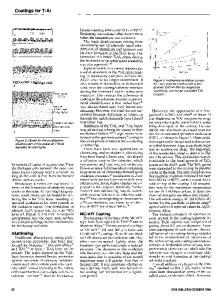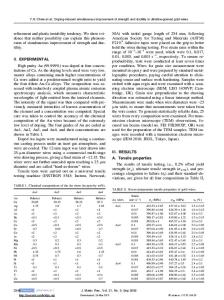Parameters for Ductility Improvement in TiAl
- PDF / 350,711 Bytes
- 6 Pages / 420.48 x 639 pts Page_size
- 76 Downloads / 846 Views
PARAMETERS FOR DUCTILITY IMPROVEMENT IN TiAl T. Kawabata, Takashi Tamura* and 0. Izumi Institute for Materials Research, Tohoku University, Sendai, 980, Japan. * Graduate Student of Tohoku University; Present address, NKK Corporation, Kawasaki, 210, Japan. ABSTRACT The effect of the Ti/Al ratio and third elements (Cr, Hf and Nb) on the mechanical properties of TiAl has been studied. Solution hardening in these elements is so large that, e.g., the strength doubles by the addition of 3 at.% Cr. Ductility to fracture strain has been improved up to 2.7 % and 2.7 % by the Cr addition and the use of high purity base metals, respectively. Parameters relating to the improvement of ductility have been discussed. Namely, the improvement of ductility was caused by the decreases of the grain size, axial ratio and impurity. A hypothesis has been proposed that the ductility improvement was related with the excess shrinkage of volume of a unit cell due to the addition of the third element which implies the strengthening of chemical bonds and vice versa. The effect of twins and a lamellar structure with the plate-like Ti 3 AI and the matrix on the ductility have been discussed. INTRODUCTION TiAl is a potentially useful alloy for use as a heat resistant material. It has a specific gravity of 3.8, high strength and high creep resistance at high temperatures [1]. However, TiAl has not yet been used industrially as it is brittle below 900 K [2]. Therefore, improvement of the ductility is a main problem for development of new heat resistant materials. Lipsitt et al [2] have shown that ductility of Ti-40 mass% Al was about 0.1 % in plastic strain at room temperature. Ductility of Ti-48 at.% Al was improved by the V additions of 0.5 and 2.5 at.% at 473 K [3]. The Mn addition caused a ductility improvement in Ti-rich TiAl changing the microstructure with highly dense twins and Ti 3 Al thin plates on interfaces of the twins [4, 5]. W stabilized the ý phase in TiAl resulting in development of the structure with a small grain size and improvement of ductility [6]. In the present study, we report the effect of the deviation from stoichiometry, the grain size, the lattice parameters and the axial ratio, the strengthening of a chemical bond due to third elements, the use of high purity base metals and the second phase Ti 3 Al on the room temperature ductility of TiAl. EXPERIMENTAL PROCEDURE Ti and Al of 99.7 and 99.99 % purity, respectively, were used to melt for alloys in an arc furnace with a tungsten electrode in Ar atmosphere. The alloy compositions are shown in Table 1. Ingots were annealed at 1273 K for 605 ks in vacuum. Mechanical propertie• were studied using four point bend tests at a strain rate of 8.3 x 10' s- , at room temperature and in air in an Instron testing machine. The size of the specimens was 9 mm in length, 5 mm in width and 1 mm in thickness. The specimens were polished with emery paper and then el ectrolytically. Yield and fracture stresses and fracture strains were evaluated at the surface of specimens. Microstructures
Data Loading...











